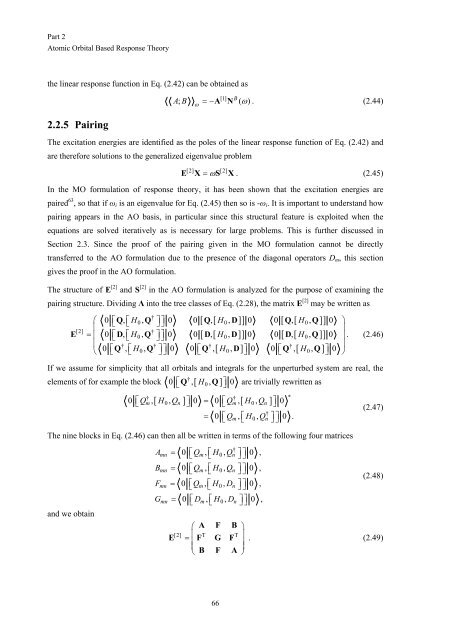Get my PhD Thesis
Get my PhD Thesis
Get my PhD Thesis
Create successful ePaper yourself
Turn your PDF publications into a flip-book with our unique Google optimized e-Paper software.
Part 2<br />
Atomic Orbital Based Response Theory<br />
the linear response function in Eq. (2.42) can be obtained as<br />
[1]<br />
B<br />
AB ; ω<br />
=−A N ( ω)<br />
. (2.44)<br />
2.2.5 Pairing<br />
The excitation energies are identified as the poles of the linear response function of Eq. (2.42) and<br />
are therefore solutions to the generalized eigenvalue problem<br />
[2] [2]<br />
E X = ωS X. (2.45)<br />
In the MO formulation of response theory, it has been shown that the excitation energies are<br />
paired 63 , so that if ω i is an eigenvalue for Eq. (2.45) then so is -ω i . It is important to understand how<br />
pairing appears in the AO basis, in particular since this structural feature is exploited when the<br />
equations are solved iteratively as is necessary for large problems. This is further discussed in<br />
Section 2.3. Since the proof of the pairing given in the MO formulation cannot be directly<br />
transferred to the AO formulation due to the presence of the diagonal operators D m , this section<br />
gives the proof in the AO formulation.<br />
The structure of E [2] and S [2] in the AO formulation is analyzed for the purpose of examining the<br />
pairing structure. Dividing Λ into the tree classes of Eq. (2.28), the matrix E [2] may be written as<br />
†<br />
⎛ 0 ⎡⎣Q, ⎡⎣H0, Q ⎤⎤ ⎦⎦ 0 0 [ Q, [ H0, D]<br />
] 0 0 [ Q, [ H0, Q]<br />
] 0 ⎞<br />
[2]<br />
⎜<br />
⎟<br />
†<br />
E = ⎜ 0 ⎣⎡D, ⎣⎡H0, Q ⎦⎦ ⎤⎤ 0 0 [ D, [ H0, D]<br />
] 0 0 [ D, [ H0, Q]<br />
] 0 ⎟. (2.46)<br />
⎜ † † † †<br />
⎟<br />
⎝ 0 ⎣⎡Q , ⎣⎡H0, Q ⎦⎦ ⎤⎤ 0 0 ⎣⎡Q ,[ H0, D] ⎦⎤ 0 0 ⎣⎡Q ,[ H0, Q]<br />
⎦⎤<br />
0 ⎠<br />
If we assume for simplicity that all orbitals and integrals for the unperturbed system are real, the<br />
†<br />
elements of for example the block 0 ⎡⎣Q ,[ H0<br />
, Q ] ⎤⎦<br />
0 are trivially rewritten as<br />
† †<br />
∗<br />
0 ⎡⎣Qm, [ H0, Qn ] ⎤⎦ 0 = 0 ⎡⎣Qm, [ H0, Qn<br />
] ⎤⎦<br />
0<br />
(2.47)<br />
†<br />
= 0 ⎡⎣Qm, ⎡⎣H0<br />
, Qn<br />
⎤⎤ ⎦⎦ 0 .<br />
The nine blocks in Eq. (2.46) can then all be written in terms of the following four matrices<br />
and we obtain<br />
†<br />
mn m 0 n<br />
A = 0 ⎡⎣Q , ⎡⎣H , Q ⎤⎤ ⎦⎦ 0 ,<br />
Bmn = 0 ⎡⎣Qm , ⎡⎣H0<br />
, Qn<br />
⎤⎤ ⎦⎦ 0 ,<br />
(2.48)<br />
Fmn = 0 ⎡⎣Qm , ⎡⎣H0<br />
, Dn<br />
⎤⎤ ⎦⎦ 0 ,<br />
Gmn = 0 ⎡⎣Dm , ⎡⎣H0<br />
, Dn<br />
⎤⎤ ⎦⎦ 0 ,<br />
⎛ A F B ⎞<br />
[2] ⎜ T T<br />
E = F G F<br />
⎟<br />
. (2.49)<br />
⎜<br />
⎟<br />
⎝ B F A ⎠<br />
66

















